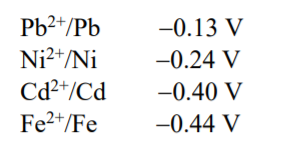Faraday constant
depends on the amount of the electrolyte
depends on the current in the electrolyte
is a universal constant
depends on the amount of charge passed through the electrolyte
Step by step video & image solution for Faraday constant by Physics experts to help you in doubts & scoring excellent marks in Class 12 exams.
Updated on:21/07/2023Topper's Solved these Questions
- THERMAL AND CHEMICAL EFFECT OF ELECTRIC CURRENTBOOK - HC VERMACHAPTER - THERMAL AND CHEMICAL EFFECT OF ELECTRIC CURRENTEXERCISE - Objective 2
5 Videos
- THERMAL AND CHEMICAL EFFECT OF ELECTRIC CURRENTBOOK - HC VERMACHAPTER - THERMAL AND CHEMICAL EFFECT OF ELECTRIC CURRENTEXERCISE - Exercises
24 Videos
- THERMAL AND CHEMICAL EFFECT OF ELECTRIC CURRENTBOOK - HC VERMACHAPTER - THERMAL AND CHEMICAL EFFECT OF ELECTRIC CURRENTEXERCISE - Short Answer
9 Videos
- THE SPECIAL THEORY OF RELATIVITYBOOK - HC VERMACHAPTER - THE SPECIAL THEORY OF RELATIVITYEXERCISE - Exercise
1 Videos
- X-RaysBOOK - HC VERMACHAPTER - X-RaysEXERCISE - Exercises
27 Videos
Similar Questions
A current of 1A is possed through a dilute solution of sulphuric acid for some time to liberate 1g of oxygen. How much hydrogen is liberated during this period? How long was the current passed? Faraday constant =96500Cmol−1.
View SolutionIt is desired to deposit 0.254 kg of copper on the cathode of a copper voltameter . How long will it take to deposit this amount if a steady current of 100 A is maintained . Use the known value of Faraday constant . Relative atomic mass of copper is 63.5 .
View Solution
Knowledge Check
Electrolysis is the process in which electrical energy is converted to chemical energy. In electrolytic cell, oxidation takes place at anode and reduction at cathode. Electrode process depends on the electrode taken for electrolysis. Amount of substance liberated at an electrode is directly propertional to the amount of charge passed through it. The mass of substance liberated at electrode is calculated using the following relation :
m=ItE96500
Here, E represents the equivalent mass and 96500 C is called the Faraday constant. Faraday (96500 C) is the charge of 1 mole electron, i.e., 6.023×1023 electrons, it is used to liberate one gram equivalent of the substance.
How many faradays are required to reduce 1 mol BrO−3 to Br− ?A3B5C6D4Suppose that gold is being plated on to another metal in an electrolytic cell. The half - cell reaction producing the Au(s) is AuCl−4+3e−+Au(s)+4Cl−. If a 0.30 A current runs for 15.00 minute, what mass of Au(s) will be plated, assume all the electrons are used in the reduction of AuCl−4 ? the Faraday constant is 96485 C/mol and molar mass of Au is 197.
A0.184 gB0.551 gC1.84 gD0.613 gSuppose that gold is being plated on to another metal in an electrolytic cell. The half-cell reaction producing the Au(s) isAuCl−4+3−→Au(s)+4Cl−. If a 0.30 A current runs for 15 min, what mass of Au(s) will be plated, assume all the electrons are used in the reduction of AuCl−4 ? The Faraday constant is 96485C/mol and molar mass of Au is 197.
A0.184 gB0.551 gC1.84 gD0.613 g
A current of 1 A is passed through a dilute solution of sulphuric acid for some time to liberate 1 g of oxygen. How much hydrogen is liberated during this period ? How long the current was passed ? Faraday constant =96500mol−1
View SolutionSome standard electrode potentials at 298K are given below:

To a solution containing 0.001M of X2+ and 0.1M of Y2+, the metal rods X and Y are inserted (at298K) and connected by a conducting wire. This resulted in dissolution of X. The correct combinations of X and Y, respectively is (are)
(Given: Gas constant, R=8.314JK−1mol−1, Faraday constant,F= 96500Cmol−1)
View SolutionConsider the following cell reaction Cd(s)+Hg2SO4+95H2O(l)→CdSO4.95H2O(s)+2Hg(l)
The value of E0cell n is 4.315 V at 25∘ C. If △H∘=−825.2kjmol−1 the standard entropy change △S∘ in J K−1 is_________ (Nearest integer) [Given : Faraday constant = 96487 C mol−1 ]
View SolutionA steady current of 10.0 A is passed through a water voltameter for 300 s . Estimate the volume of H2 evolved at standard temperature and pressure . Use the known value of Faraday constant . Relative molecular mass of H2 is 2.016 and molar volume = 22.4 litres (volume of 1 mol of an ideal gas at STP).
View SolutionA study potential difference of 1.62 V is maintained across two Pt electrodes placed in a solution of CuCl2 . At the end of 600s, the mass of copper deposited on the cathode is measured to be 5.92 g. The back emf of the voltameter is given to be 1.34 V. Estimate the resistance of voltameter. Faraday constant =96500 C mol−1, relative atomic mass of copper =63.5.
View Solution
